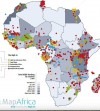In Africa, wheat consumption is booming, driven by strong urban demand. The productive apparatus is therefore strongly called upon to improve supply and reduce imports.
Between 2000 and 2020, the African continent recorded the highest overall increase in productivity for wheat. This is what emerges from FAO data compiled by the Ecofin Agency.
Over the said period, Africa saw its yield per hectare increase from 1.75 tonnes to 2.54 tonnes, an increase of 44%. This level is higher than the global average increase (28%) as well as that of the major production areas of Asia (32%) and Europe (25%). According to the UN body, all the main grass-growing sub-regions on the continent have improved their performance compared to the beginning of the 21st century.
In detail, East Africa has recorded the most significant progress with productivity per hectare which has more than doubled from 1.3 tonnes in 2000 to 2.96 tonnes in 2020. But this is the Africa which holds the prize for the highest yield (4.1 tonnes/ha). For its part, West Africa posted a yield of 1.66 tonnes in 2020, i.e. 11% more than in 2000, while in North Africa, the main consumption zone, the yield rose by 34% at 2.3 tons.
According to the FAO, the increase in yields drove African production, which rose from 14.2 million tonnes to 25.3 million tonnes, an increase of 77%. During this time, the areas sown increased by 22.5% reaching 9.98 million hectares.
More generally, while wheat is the most imported cereal in Africa, the organization’s data indicate that it is the grass which has experienced the greatest increase in its productivity between 2000 and 2020, ahead of maize which has increased by 16% to 2 tonnes/ha and rice where a contraction of 5% was observed (2.2 tonnes).
It is also the grain for which Africa has the smallest yield gap with the rest of the regions of the world.





























Réagissez à cet article